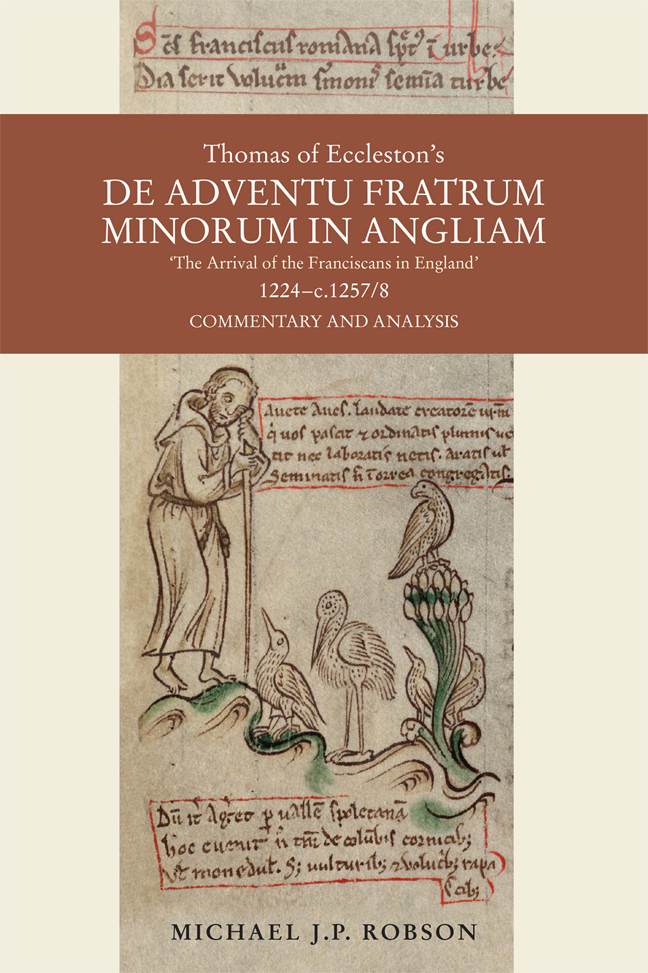Book contents
- Frontmatter
- Dedication
- Contents
- Acknowledgements
- List of Abbreviations
- Timeline
- Introduction
- 1 The launching of the mission to England
- 2 The first foundations
- 3 The admission of novices
- 4 The growth of the Franciscan community
- 5 The fervour of the early friars
- 6 The office of preaching
- 7 The seven custodies
- 8 The three general visitators
- 9 The Irish and Scottish provinces
- 10 The relocation of friaries and their enlargement
- 11 The friars’ schools of theology
- 12 The confessors
- 13 The ministers general
- 14 The ministers provincial
- 15 A gallery of friars
- A post script
- Bibliography
- Index
- Miscellaneous Endmatter
6 - The office of preaching
Published online by Cambridge University Press: 02 March 2024
- Frontmatter
- Dedication
- Contents
- Acknowledgements
- List of Abbreviations
- Timeline
- Introduction
- 1 The launching of the mission to England
- 2 The first foundations
- 3 The admission of novices
- 4 The growth of the Franciscan community
- 5 The fervour of the early friars
- 6 The office of preaching
- 7 The seven custodies
- 8 The three general visitators
- 9 The Irish and Scottish provinces
- 10 The relocation of friaries and their enlargement
- 11 The friars’ schools of theology
- 12 The confessors
- 13 The ministers general
- 14 The ministers provincial
- 15 A gallery of friars
- A post script
- Bibliography
- Index
- Miscellaneous Endmatter
Summary
At the heart of the Franciscan vocation was the mandate to disseminate the Gospel. Like St Francis, each friar was challenged to bring the teaching of Jesus to life by their words and deeds; the friars’ vocation was to take the Gospel wherever there were people, to the ends of the earth. Friars preached in religious houses and parish churches, but they were soon drawn to open places, where, following the example of Sts Francis and Anthony, they expounded the Scriptures. Their persuasive ministry applied the Gospel to the norms of the market place. Friars preached to members of the aristocracy, bishops, cardinals, children, clerics, heretics, kings, masters in the schools, merchants, nobles, nuns, paupers, peasants, priests, popes, students and tradesmen. Similarly, their churches were designed to accommodate the large number of people who flocked there to hear their flamboyant and charismatic preaching. Preachers were appointed by the general chapter of the order. Friars selected for the office of preaching were to instruct their neighbours in applying the Gospel to the life of the merchant, the urban tradesman and the rural farmer. The threefold focus to this preaching – first, to the laity; secondly, to the clergy; and thirdly, the sermons preached to the friars by friars or their benefactors – leads to the preaching of Haymo of Faversham.
The mandate to preach the Gospel to the laity
From the 1220s friars were investing a great deal of energy in their ministry of preaching. They were ardent in their study of theology and scholastic exercises. They were so enthusiastic that, however far they might have to travel (quantumcumque distarent) to the schools of theology (scholas theologiae), they went there daily bare-footed (nudis pedibus) in the bitter cold and the deep mud (luti profunditate). This passage is more applicable to Paris than to Oxford, especially because the friary at St-Denis lay in the northern suburbs, some nine kilometres from the centre of the city. The identity of the master to whom the friars attached themselves is unknown, as are details of how they funded their teaching. Did benefactors pay on their behalf ? There is no extant documentary support for the hypothesis that they attended the school of Alexander of Hales. Sustained study prepared the friars for the office of preaching.
- Type
- Chapter
- Information
- Thomas of Eccleston's De adventu Fratrum Minorum in Angliam 'The Arrival of the Franciscans in England', 1224-c. 1257/8Commentary and Analysis, pp. 114 - 139Publisher: Boydell & BrewerPrint publication year: 2023

